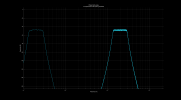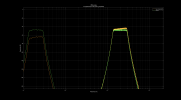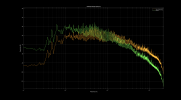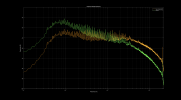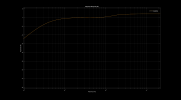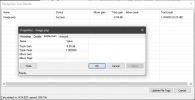xnor
Active Member
- Joined
- Jan 12, 2022
- Messages
- 193
- Likes
- 209
Heya,
there's a couple of threads asking about safe listening levels and people asking about voltage/power requirements in almost any amp/headphone thread.
Here's my take on this:
Noise Exposure Limits
The EPA and WHO recommend that noise should be kept below 70 dBA over 24 hours and below 75 dBA over 8 hours. Additionally, the CDC makes the rough recommendation to keep noise exposure below 2 hours for 80-85 dBA loud noise as (based on the same data and 3 dB exchange rate) to prevent hearing damage.
NIOSH defines a 3 dB exchange rate: permissible exposure time halves for every 3 dB increase in noise intensity.
NIOSH recommends a limit of occupational noise exposure to 85 dBA over an 8-hour time-weighted average.
EPA recommends noise exposure to be limited to 85 dBA over 45 minutes.
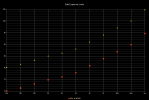
Why this discrepancy? The answer is in the:
Fine print
The EPA limits were chosen to protect 96% of the general population against impairment of physical (hearing loss) and mental (like discomfort) health.
The NIOSH limits were chosen solely to protect against hearing loss in the workplace accepting that 8% of the workforce will still develop hearing loss.
Therefore, NIOSH recommends hearing protection if noise levels exceed 85 dBA regardless of exposure duration.
The EPA limit is averaged over 24 hours.
The NIOSH limit is averaged over 8 hours (average workday) with rest/recovery periods between exposures.
The EPA limit is based on 365 days/year exposure.
The NIOSH limit is based on 250 workdays/year exposure.
The NIOSH limit considers implementation cost for businesses to stay within limits (sacrificing human health for economic reasons).
Note: both recommendations are based on audiometric tests of hearing loss up to 4 kHz.
Note: OSHA (which records occupational hearing loss cases) defines a significant decrease in hearing as a "standard threshold shift" which is a change of 10 dB averaged over 2, 3, and 4 kHz.
A-Weighting
A-weighting significantly attenuates low frequencies, while giving a slight boost to frequencies between 1 kHz and 6 kHz (the peak is about +1.3 dB at 2.5 kHz):
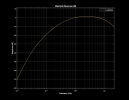
Conclusions
85 dBA should not be considered a universally safe limit, especially not for children, people with sensitive hearing, when regularly listening for several hours, or when being exposed to other potentially louder noise sources throughout the day.
Therefore, I recommend to stay below 85 dBA when listening to music.
Power/Voltage Requirements
This depends on headphone sensitivity and type of music you're listening to:
Headphone sensitivity
You can find this in product datasheets. If it's just specified as "x dB" then it is usually at 1 mW. Sensitivity is sometimes also specified at 1 Vrms.
Both are typically measured with a 500 Hz or 1 kHz sine wave.
To convert from dB SPL@1 mW to dB SPL@1 Vrms and vice-versa, calculate:
Note that a sine wave's RMS value is 3 dB lower than its peak magnitude. This needs to be considered when we analyze the RMS value of music tracks.
Additionally, we have to apply the A-weighting.
Music
Let's look at two extremes: classical recordings and highly dynamic range compressed modern pop/rock.
Note: the selection of tracks used for this analysis is random. Ymmv.
Classical:
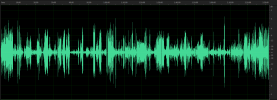
Total RMS value: -24.1 dB
Total RMS value with A-weighting: -26.85 dB.
Modern pop/rock
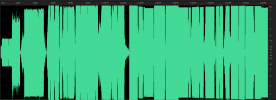
Total RMS value: -11.2 dB
Total RMS value with A-weighting: -15 dB.
The differences in A-weighting (-2.75 dB for classical and -3.8 dB for modern pop/rock) is explained due to the fact that modern pop/rock has significantly more energy in bass/lower mids and also upper treble, which is exactly what the A-weighting filter attenuates.
So how much power/voltage do I need?
Now we have all the information we need:
Amplifier gain, volume setting and headroom
Knowing the required voltage and the output voltage of your source device, calculating the required gain with optional added headroom is as simple as:
The actual gain of your amp may be higher, which means you'll have to turn down the volume. By how much? Calculate:
I've also published a Headphone power spreadsheet that contains these calculations. Feel free to clone/download it.
Sources
there's a couple of threads asking about safe listening levels and people asking about voltage/power requirements in almost any amp/headphone thread.
Here's my take on this:
Noise Exposure Limits
The EPA and WHO recommend that noise should be kept below 70 dBA over 24 hours and below 75 dBA over 8 hours. Additionally, the CDC makes the rough recommendation to keep noise exposure below 2 hours for 80-85 dBA loud noise as (based on the same data and 3 dB exchange rate) to prevent hearing damage.
NIOSH defines a 3 dB exchange rate: permissible exposure time halves for every 3 dB increase in noise intensity.
NIOSH recommends a limit of occupational noise exposure to 85 dBA over an 8-hour time-weighted average.
EPA recommends noise exposure to be limited to 85 dBA over 45 minutes.

Why this discrepancy? The answer is in the:
Fine print
The EPA limits were chosen to protect 96% of the general population against impairment of physical (hearing loss) and mental (like discomfort) health.
The NIOSH limits were chosen solely to protect against hearing loss in the workplace accepting that 8% of the workforce will still develop hearing loss.
Therefore, NIOSH recommends hearing protection if noise levels exceed 85 dBA regardless of exposure duration.
The EPA limit is averaged over 24 hours.
The NIOSH limit is averaged over 8 hours (average workday) with rest/recovery periods between exposures.
The EPA limit is based on 365 days/year exposure.
The NIOSH limit is based on 250 workdays/year exposure.
The NIOSH limit considers implementation cost for businesses to stay within limits (sacrificing human health for economic reasons).
Note: both recommendations are based on audiometric tests of hearing loss up to 4 kHz.
Note: OSHA (which records occupational hearing loss cases) defines a significant decrease in hearing as a "standard threshold shift" which is a change of 10 dB averaged over 2, 3, and 4 kHz.
A-Weighting
A-weighting significantly attenuates low frequencies, while giving a slight boost to frequencies between 1 kHz and 6 kHz (the peak is about +1.3 dB at 2.5 kHz):

Conclusions
85 dBA should not be considered a universally safe limit, especially not for children, people with sensitive hearing, when regularly listening for several hours, or when being exposed to other potentially louder noise sources throughout the day.
Therefore, I recommend to stay below 85 dBA when listening to music.
Power/Voltage Requirements
This depends on headphone sensitivity and type of music you're listening to:
Headphone sensitivity
You can find this in product datasheets. If it's just specified as "x dB" then it is usually at 1 mW. Sensitivity is sometimes also specified at 1 Vrms.
Both are typically measured with a 500 Hz or 1 kHz sine wave.
To convert from dB SPL@1 mW to dB SPL@1 Vrms and vice-versa, calculate:
Code:
sensitivity_Vrms = sensitivity_mW - 10*log10(0.001 * impedance)
sensitivity_mW = sensitivity_Vrms + 10*log10(0.001 * impedance)Note that a sine wave's RMS value is 3 dB lower than its peak magnitude. This needs to be considered when we analyze the RMS value of music tracks.
Additionally, we have to apply the A-weighting.
Music
Let's look at two extremes: classical recordings and highly dynamic range compressed modern pop/rock.
Note: the selection of tracks used for this analysis is random. Ymmv.
Classical:

Total RMS value: -24.1 dB
Total RMS value with A-weighting: -26.85 dB.
Modern pop/rock

Total RMS value: -11.2 dB
Total RMS value with A-weighting: -15 dB.
The differences in A-weighting (-2.75 dB for classical and -3.8 dB for modern pop/rock) is explained due to the fact that modern pop/rock has significantly more energy in bass/lower mids and also upper treble, which is exactly what the A-weighting filter attenuates.
So how much power/voltage do I need?
Now we have all the information we need:
- The target SPL: 85 dB SPL
- Sensitivity in dB SPL either @1 mW or @1 Vrms
- Weighted total RMS value
power_mW = 10^((target_spl - sensitivity_mW - weighted_rms - 3)/10)
voltage_rms = 10^((target_spl - sensitivity_Vrms - weighted_rms - 3)/20)Amplifier gain, volume setting and headroom
Knowing the required voltage and the output voltage of your source device, calculating the required gain with optional added headroom is as simple as:
Code:
headroom_x = 10^(headroom_dB/20)
min_amp_gain_x = voltage_rms/source_rms * headroom_x
min_amp_gain_dB = 20*log10(min_amp_gain_x)The actual gain of your amp may be higher, which means you'll have to turn down the volume. By how much? Calculate:
Code:
volume_x = min_amp_gain_x / amp_gain_x
volume_dB = 20*log10(volume_x)I've also published a Headphone power spreadsheet that contains these calculations. Feel free to clone/download it.
Sources
- CDC. What Noises Cause Hearing Loss?. https://www.cdc.gov/nceh/hearing_loss/what_noises_cause_hearing_loss.html
- EPA [1974]. Information on levels of environmental noise requisite to protect public health and welfare with adequate margin of safety. EPA/ONAC 550/9-74-004. http://nepis.epa.gov/Exe/ZyPDF.cgi/2000L3LN.PDF?Dockey=2000L3LN.PDF
- NIOSH [1998]. Criteria for a recommended standard: occupational noise exposure. DHHS (NIOSH) Publication Number 98-126. https://www.cdc.gov/niosh/docs/98-126/
Last edited:
